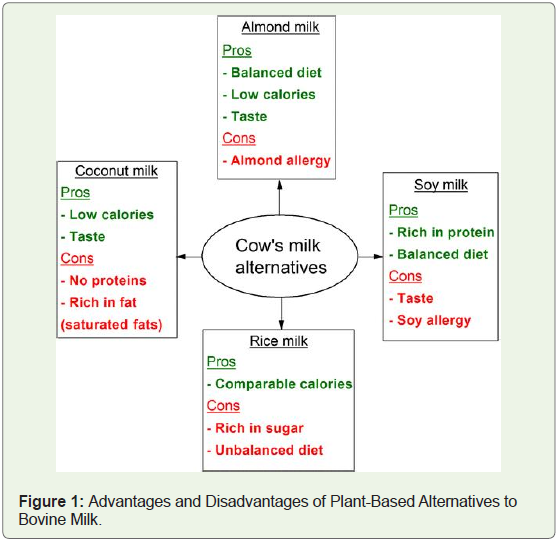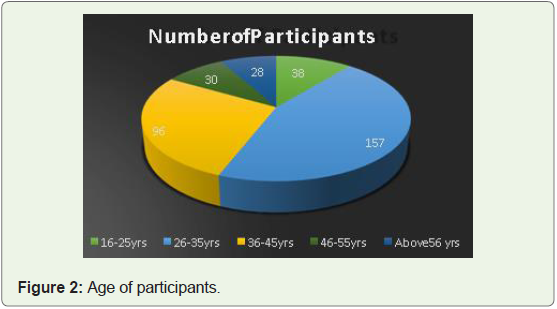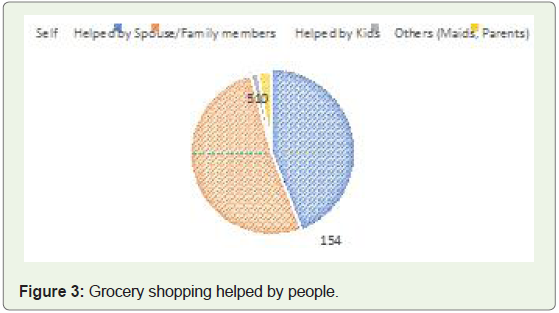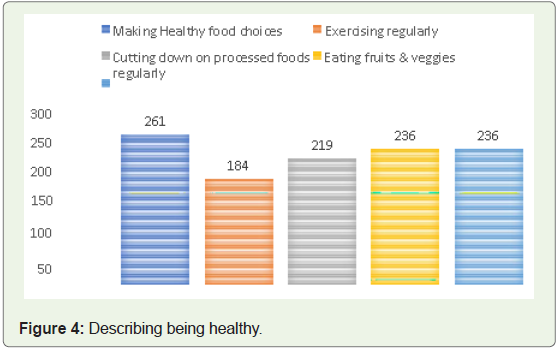Research Article
A Survey on Knowledge, Attitude and Practice of Dairy and Non Dairy Alternatives amongst Indian Population
Pramod N1*, Nagendra A2 and Mukund S3
1Department of Nutrition, Sports Authority of India, Bengaluru, India
2Department of Nutrition and Dietetics, Sagar Chandramma Hospitals, Bengaluru, India
3Nutritionist&Dietitian, Founder Nutrizen, Hyderabad, India
*Corresponding author: Pramod N, Department of Nutrition, Sports Authority of India, Bengaluru, India; E-mail:
namrathapramod@gmail.com
Article Information: Submission: 08/09/2022; Accepted: 19/10/2022; Published: 22/10/2022
Copyright: © 2022 Pramod N, et al. This is an open access article distributed under the Creative Commons Attribution License, which
permits unrestricted use, distribution, and reproduction in any medium, provided the original work is properly cited.
Abstract
The Greek mythology illustrates Milky Way formed out of breast milk of the Queen Hera, Zeus’s wife the night sky. Milk plays a very important role in
our culture from feeding the children to special offering to God and in various beauty cosmetics. Milk is an emotion more than a dairy product. India being
the world’s largest milk producer, responsible for 22% of global production. In the past decade, major research emphasis in all sections of food product
development is to address the changing needs and to meet the present demands of consumer by creating newer alternative of health foods.
Objectives: To understand the Knowledge, Attitude and Practice of the participants towards different kinds of Dairy and Non-Dairy milk available in the market.
Methodology: The google forms were circulated in India and abroad. A total of 349 responses were received.
Results: Soya milk was popular milk 81.9% of participants were aware of it. Participants choose Non-Dairy over Dairy products as healthy alternatives.
The participants attributed to taste (65 participants) and to being natural. Lactose intolerance and veganism were also a reason forswitch.106 participants were
ready to try non-dairy products. Almost 79.1% were aware of then on-Diary milk available in the Market.
Conclusion: Knowledge on non-dairy products was present among the participants. The attitude for change was observed on a positive note. Maximum
participants choose Non-Dairy over Dairy products as healthy alternatives.
Keywords
Milk; Non dairy products; Plant-based diet
Introduction
Milk is one of the most commonly consumed food products
and relished by the human population for more than 8000 years,
due to its nutritional value and its versatility in satiating appetite.
Milk is a wholesome complete food as it contains several essential
nutrients and is an important part of dietary recommendations in
many countries [1,2]. However, dairy production has gone through
several environmental impacts. The most probable environmental
issues associated to production of milk are air and water pollution,
soil degradation and loss of biodiversity.
Recently, consumers have shifted towards plant-based diet which
includes cereal, legumes, seeds, nuts, fruits and vegetables because of
varied reasons such as an aversion to animal savagery, environmental
awareness and an inclination for a healthy lifestyle [4]. Therefore,
trends like veganism, vegetarianism, lacto-vegetarianism and ovovegetarianism
have emerged.
Over the past decade, major research emphasis in food product
development is to address the changing needs and to meet the current
demands of consumer by creating new alternatives for health foods.
In today’s world, beverages are no longer considered simply as thirst quenchers; consumers look for specific functionality in these
drinks, which forms a part of their lifestyle [5]. Thus, acceptance and
experience of a new food depend upon various factors including a good
odor, familiar taste, health benefits, nutritional information, and also environmental aspects of the product. All these criteria
have an impact on increasing or decreasing the public’s willingness to
try a new food product [6].
Nowadays, due to its numerous positive health benefits, the
use of plant-based milk alternatives has widely spread across the
globe. It may be a right choice for people looking out for dairy free
alternatives [5]. Individuals with cow’s milk allergy, lactose intolerance, calorie concern or hypo-cholesterolemia may prefer these
beverages or products. These plant-based alternatives can also serve
as an inexpensive alternate to poor economic group of developing
countries and in places, where cow’s milk supply is insufficient.
Plant-based milk alternatives are basically fluids that results
from the breakdown (size reduction) of plant material, like -cereals,
pseudo-cereals, legumes, oilseeds and nuts. Which is then extracted
in water and further homogenized? Such fluids result in particle size
distribution between the ranges of 5-20 ml which imitates the cow’s
milk in appearance and consistency.
Although, there is no stated definition and classification of these
plant-based milk alternatives in literature, a general classification
with five categories is attempted, which is as follows:
➢ Cereal based: Oat milk, Rice milk, Corn milk, Spelt milk.
➢ Legume based: Soy milk, Peanut milk, Lupin milk, Cow pea
milk.
➢ Nut based: Almond milk, Coconut milk, Hazelnut milk,
Pistachio milk, Walnut milk.
➢ Seed based: Sesame milk, Flax milk, Hemp milk, Sunflower
milk.
➢ Pseudo-cereal based: Quinoa milk, Teff milk, Amaranth milk
[7].
When compared to bovine milk, most of these milk alternatives
lack nutritional balance; however they contain functionally active
components with health promoting properties which attracts the
health-conscious consumers. But, in the vegan food industry, plantbased
milk substitutes are one of the unique food groups that cannot
be replaced as they are used as a key ingredient in many vegan food
products such as plant-based yogurt, cheese, butter, ice cream, etc [8]
(Figure 1).
Methodology
The pandemic had brought life to a standstill but the technology
enables us to do the impossible. Google forms were used for the
survey. The google forms were circulated in India and abroad.
However, this was not possible with other methods of survey. A total
of 349 responses were received.
Procedures:
Google forms were circulated with a covering letter mentioning the need and the study, the purpose of the study .A paragraph about
confidentiality was also mentioned in the covering letter. The survey
was a voluntary; those who were willing only participated in the
survey. The results were complied thereafter.Demographic Information:
The survey method had a positive response in a short time. 349
subjects participated in the survey. 94 (27%) were male and 255 (73%)
were female. The age group that was surveyed had varied participant’s
between16years to above 56years. Majority of the participants were
between the age group 26- 35 years, 157 (45%) participants. 96
participants (27.5%) were between age group 36 - 45 years. A mere
number of participants 28 (8%) were above56 years (Figure 2).Assessment of nutritional knowledge:
54% of the retail market constitutes of food and grocery. The
knowledge gap about market and consumers is one of the constrain
for the large companies to enter the retail market even after a huge
growth potential. Parameters considered important by customers
during shopping have not been studied enough [10].In the study the helpers for grocery shopping were identified and
studied to access the nutritional knowledge of the participants 154
(44 %) shopped by themselves and a large amount 180 (51%) were
assisted by their spouses. 10 (35%) were helped by maids or parents
and 5(2%) were helped by their kids (Figure 3).
According to WHO, Health is a state of complete physical,
mental and social well-being and not merely the absence of disease
or infirmity [11].
WHO’s Global Health Estimates, states the top 10 reasons for
death globally in 2019 in which ischemic heart disease tops the chart
[12]. The estimates showed the link between eating pattern and being
healthy and symptoms of IHD (Ischemic Heart disease) like blood
pressure, diabetes and Obesity (Figure 4).
Results
This Study has showed that most of the participants were middle
aged (between 25-35 years) with a family income of lesser than 30,000
per month. 58.5% participants concluded that nondairy milk was
more expensive than dairy milk and 19.8% participants thought dairy
milk as affordable.
Very few participants were intolerant to milk and its products
(about 20%). Most of the participants have knowledge about nutrition
as they shopped themselves or with their spouse.
Almost 79.1% were aware of the fact that non-Diary milk
available in the Market. Among the Non-Diary milk products, about 81.9% participants were aware of Soya milk. Hemp milk was the least
identified by participants that is about11.7%.
Most of the participants were making healthy choices in food
(74.8%) by cutting down on processed foods and try healthier foods
by including more fruits, vegetables into their diet. About 52.7% were
exercising regularly.
Soya milk (57.3%), almond milk (44.4%) and coconut milk
(56.2%) were tasted by the participants. Coconut milk (12.3%) was
majorly used. Maximum participants used dairy (297) and non-dairy
milk (111) in beverages like tea and coffee and minimum participants
used them as pre bed drink.
Protein remains a most debatable nutrient for selection of milk
revealed that about 39.3%participants thought the protein content in
Non-Dairy milk were high. Also, equally large number of participants
(47.3%) thought the sugar content of Non-Dairy milk was higher as
they always were available in the sweetened forms rather than the
natural forms.
Majority of the participants used Cow’s milk (53.6%) against
buffalo milk (6.3%).
Maximum of participants (33.5%) buy milk from the local vendor.
It has impact on the variety and brand of milk. The rest (29.5%) of the
participants purchased milk from traditional booth and least (10%)
took milk from supermarket supply.
The practice of using branded milk regularly was among majority
of the participants (72.5%) and least consumed were newer brands
(2.8%) respectively. The participants (75%) were well aware of reading
food labels for various factors but minor group of participants (8%)
did not even think to read the food labels.
Maximum of 120 participants choose Non Dairy over Dairy
products as healthy alternatives. Lactose in tolerance and veganism
were also areas on for switch.
section5
Limitations of the study
Samples could have been given to check the acceptability of the
taste of various milk alternatives. Due to pandemic, this would not
have been possible. Individual target specific food inclusion and
exclusion do not have any standardized reliable diagnostic marker
show ever it is more of the individual choice.




